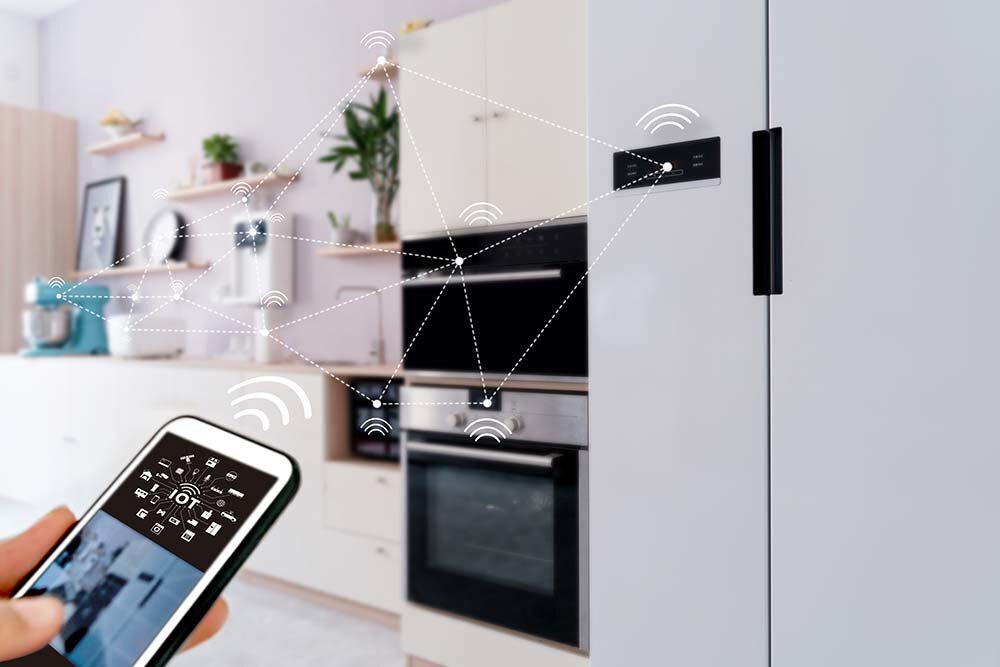Do you remember visiting Disneyland and exploring Tomorrowland, seeing the new technological fads that would be in the homes of tomorrow? Even back then, it was evident technology was going to play an active role in our lives now and in the future.
Today, we know technology has dramatically impacted our lives. As technology advances, we’re starting to see it be more prevalent in today’s homes, much like we did in the “Homes of Tomorrow” at Disneyland. Smart devices allow us to automate home processes and make our abodes more livable. The devices will enable us to connect to a central hub, which in turn will allow us to control a variety of things within the home. So, what smart technologies can be used in the house today? Read on to learn more.
Smart Appliances
Everything from refrigerators to ovens to dishwashers can have smart capabilities built into them.
Dishwashers allow you to set and program wash cycles right from your device. Smart ovens can be controlled on the go. Maybe you’re picking up a take and bake pizza and want the oven heated by the time you get home. That’s easy with a smart oven.
Some refrigerators can give you a view of their interior, in case you’re shopping and want to see if you’re out of milk. They can also alert you when it’s time to order a new water filter.
Hot Water Heaters
Some newer hot water heaters have built-in performance monitoring and leak detection. You can even set the system’s water temperature via an app.
Faucets
Newer faucets have voice-activated capabilities built into them, offering convenience when filling a measuring cup or doing the dishes. Since it can be touchless, it can be convenient if you’ve just handled raw meat or poultry to tell the faucet to turn on as opposed to touching it to turn it on.
Thermostats
Most everyone is familiar with Nest thermostats, but many other thermostats have been created to be “smart,” allowing the system to make adjustments based on when people are home automatically. Many of the smart thermostats can be controlled remotely, which is another excellent convenience. They can also ping you when a filter needs replacement or if maintenance needs to be completed on your HVAC system.
Irrigation
For a long time, irrigation used to be controlled manually. Then automated systems were created, and now there are “smart” systems that can not only be controlled via an app, they can also automatically adjust schedules based on temperatures and rainfall. Some devices can be attached to garden hoses that will turn on at designated times, or controlled remotely, to water plants and flowers.
Lighting
Many electrical components now comprise the smart home. Smart bulbs can instantly dim or change color via an app or a voice command. Individual switches can be controlled remotely or via voice as well.
Security Systems
Remember when security cameras used to be home accessories to the wealthy? Now, they’re ubiquitous in today’s homes, readily accessible via computer or your device of choice while on the go.
Garage Door Openers
A lot of today’s garage door openers have built-in WIFI, allowing them to be controlled by an app. Additionally, you can use voice commands with a smart hub to manage them. One of the great conveniences is being able to see if you’ve left a door open or not and can close it remotely. Some systems even allow you to set notifications or alarms if a door stays open for a specific duration.
Keyless Entry
Keyless entry is a relatively new option for smart homes, allowing people to enter a home by merely being in proximity of the door while using an app.
Smart Assistants / Hubs
Most smart homes do require a central hub to manage things. Amazon Echo or Google Home devices tend to do a great job in this regard, but there are other options available.
The Last Word
As you can see, smart home technology has evolved dramatically since Walt Disney’s vision of a smart home from decades ago. Suffice to say, technology is only going to become more prevalent in new homes and will be commonplace in the years to come. However, there’s an opportunity to make even older homes smarter by replacing appliances with more modern models, or when replacing outdated systems and components, using advanced components and systems that can utilize the capabilities of smart assistants.
